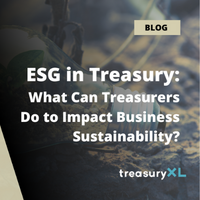ESG in Treasury: What Can Treasurers Do to Impact Business Sustainability?
01-12-2022 | Anastasia Kuznetsova | treasuryXL | LinkedIn |
The expression “Money makes the world go round” probably underscores the importance of the finance community for the transition to a greener economy. Financial market participants can significantly accelerate the transition to a more sustainable world by directing capital flows to the most sustainable projects, assets and companies.

What can treasurers do to impact business sustainability?
Corporate Treasurers can have a substantial impact on business sustainability by allocating capital to green projects as well as incorporating ESG factors in their risk management processes. Below I will summarize some of the instruments Corporate Treasurers could use to support companies on their way to sustainability.
ESG debt: Sustainability-Linked Financing
ESG debt is perhaps one of the most common instruments that may help companies to meet their ESG goals. For instance, to achieve environmental objectives, some companies issue green bonds. The proceeds from green bonds can only be spent on funding climate-related projects, including renewable energy, construction of green buildings, installation of air pollution control systems and etc. Most green bonds issued are “use of proceeds” bonds, which determine a range of eligible green project categories for which capital raised can be used. These bonds are also backed by the entire balance sheet of the issuer. Project bonds are another popular type of green bonds for which the proceeds are earmarked for specifically identified projects and are exclusively backed by the project’s assets. While green bonds might be more relevant for large public companies, private companies may still add ESG debt in their capital structures by arranging green loans which serve the same purpose as their public market bond equivalents.
Another type of ESG debt is sustainability-linked loans (SLLs), which are even more popular than green bonds and loans. The rise in popularity of SLLs may probably be explained by higher flexibility when it comes to the use of debt proceeds. Hence, the proceeds from SLLs can be spent on general corporate purposes but not exclusively earmarked for environmental projects. Moreover, SLLs are normally structured in the form of revolving credit facilities, which enables companies to fund their daily liquidity needs if they encounter a working capital deficiency. The purpose of SLLs from an ESG perspective is to encourage companies to achieve sustainability as quickly as possible. This is done by linking loan margin to a borrower’s sustainability performance. At first, sustainability performance targets (SPTs) for the borrower are established. After that, the borrower’s progress toward SPTs is monitored on annual basis via Key Performance Indicators (KPIs). If the targets are achieved, the loan’s margin will be reduced, enabling the borrower to benefit from lower interest payments. If the targets are missed, a step-up provision applies, increasing the loan’s margin and, thus, interest payments. Such an ESG Margin Ratchet provision incentivizes the borrower of SLLs to not only achieve but also maintain a certain level of ESG performance. The public markets equivalent of sustainability-linked loans is sustainability-linked bonds (SLBs) whose coupon payments are reduced (increased) if SPTs are met (missed).
On top of ESG-related loans and bonds, hybrid instruments such as green convertible bonds are becoming more and more popular. Thus, in 2020, Neoen, a French producer of renewable energy, issued €170M of the first ever green convertible bonds in Europe. This year, the company launched another €300M offering of green bonds convertible into new shares and/or exchangeable for existing shares.
Finalizing the topic of ESG debt, it is worth mentioning that when it comes to the EU’s finance providers, and particularly credit institutions who will soon have to disclose the percentage of green assets on their balance sheet under the EU Taxonomy, it is reasonable to expect that sustainability-linked debt will be favored by creditors. Specifically, being an underwriter of ESG debt could add prestige, and improve reputation and market positioning. In contrast, non-ESG debt may experience a pricing premium since such loans are likely to worsen the “greenness” of capital providers’ balance sheets.
A few words on FX Trading, Derivatives and ESG
Although currently ESG is not widely incorporated in foreign currency trades, some banks have already started to develop FX products that have a similar structure to SLLs. Such FX products will be linked to sustainability KPIs that will measure a company’s sustainability performance against pre-defined SPTs. If SPTs are successfully achieved, then a company may receive a rebate on its FX trades or a reduction in the required FX margin.
Sustainability-linked derivatives (SLDs) are another instrument that can be adopted by Treasurers to facilitate a transition of businesses to greener operations. SLDs are particularly relevant for companies, operating in “high-impact climate sectors” such as energy and agriculture. Cash flows of SLDs are connected to the sustainability performance of counterparties that is monitored via KPIs. Having met KPIs, a counterparty in a derivative transaction may receive a higher incoming payment, or be able to make a lower payment if the transaction results in a cash outflow. SLDs are OTC derivatives, meaning that counterparties can customise the derivatives’ terms and, thus, embed other ESG incentives, i.e. reduction in margin/spread, or payment of rebate upon achievement of pre-agreed sustainability targets.
Sustainable Supply Chain as an ESG trend
Sustainable supply chain is one of the current ESG trends, particularly among retailers whose total carbon footprint mainly consists of Scope 3 emissions, which are essentially emissions of suppliers. That is why, more and more companies are trying to encourage procurers to reduce their emissions and, hence, decarbonize the supply chain. Corporate Treasurers can make a substantial contribution to this objective by arranging sustainable supply chain finance programmes. Programmes are based on early-payment principles. As a first step, a company sets up sustainability KPIs to monitor the ESG performance of its suppliers. The performance of suppliers may be measured once or twice per year. After meeting at least one of the established KPIs, a supplier is paid earlier than originally agreed. Hence, highly sustainable procurers will effectively receive better payment terms, which should encourage more suppliers to improve their sustainability performance.
Sustainability Objectives and KPIs
Almost all the above-mentioned ESG products require the establishment of sustainability targets and KPIs. This unfortunately cannot be done by Treasurers on their own but instead should be done at the strategic level by company management. Sustainability targets must be ambitious, meaning that their achievement would require a substantial transformation of business models, e.g. switching to more sustainable suppliers; divestment or restructuring of high-carbon footprint units. Practice shows that not all management teams are capable of setting ambitious targets relevant to the business. Thus, the least Treasurers could do, besides the arrangement of ESG debt or other sustainability-linked products, is to question the adequacy of the chosen sustainability objectives within their organisations. In other words, Treasurers could make sure that the answer to the question “Why did your company set up its net-zero objective?” is not “Because everyone does it” but “Because it is relevant for our core business operations”.
Thank you for reading!






